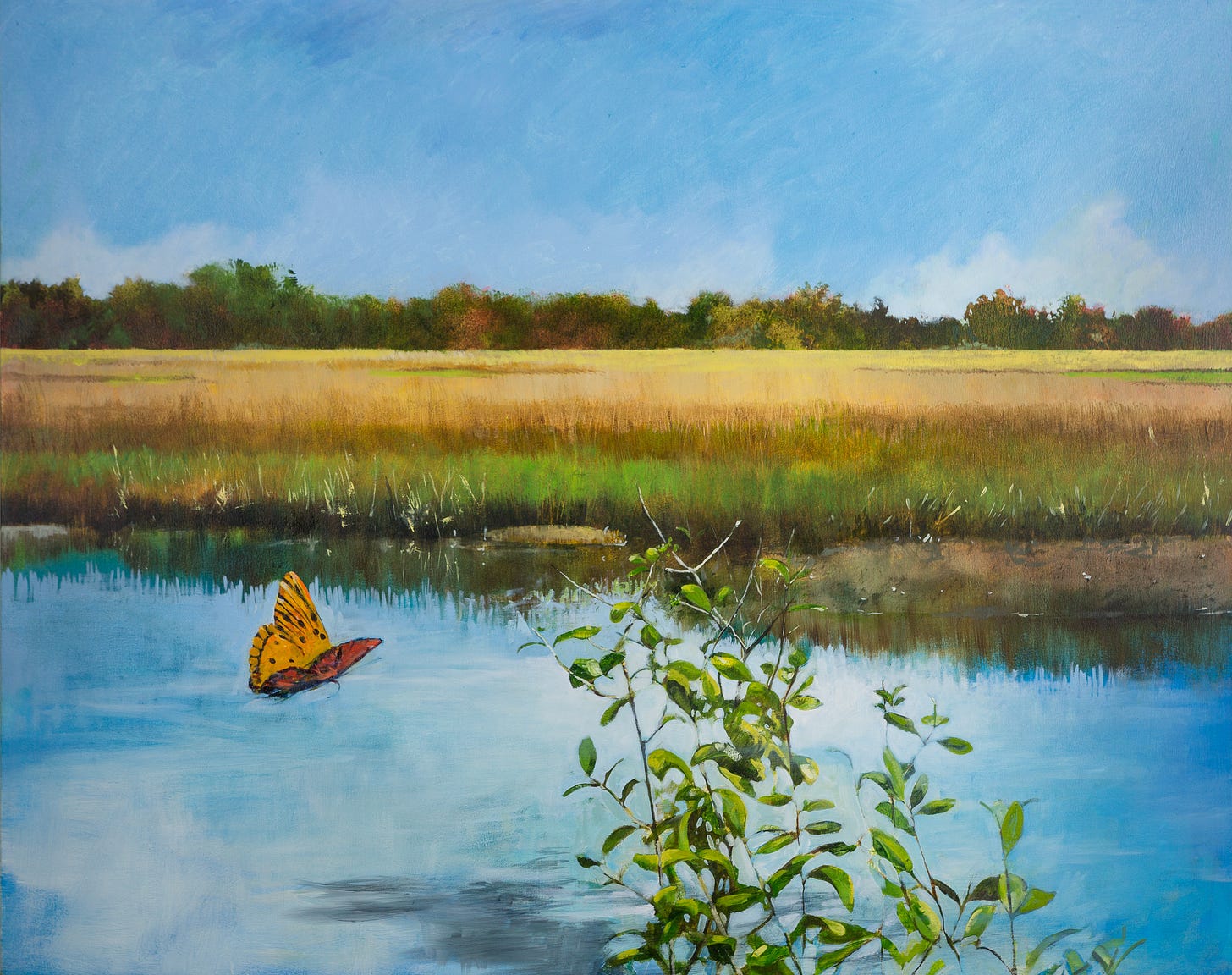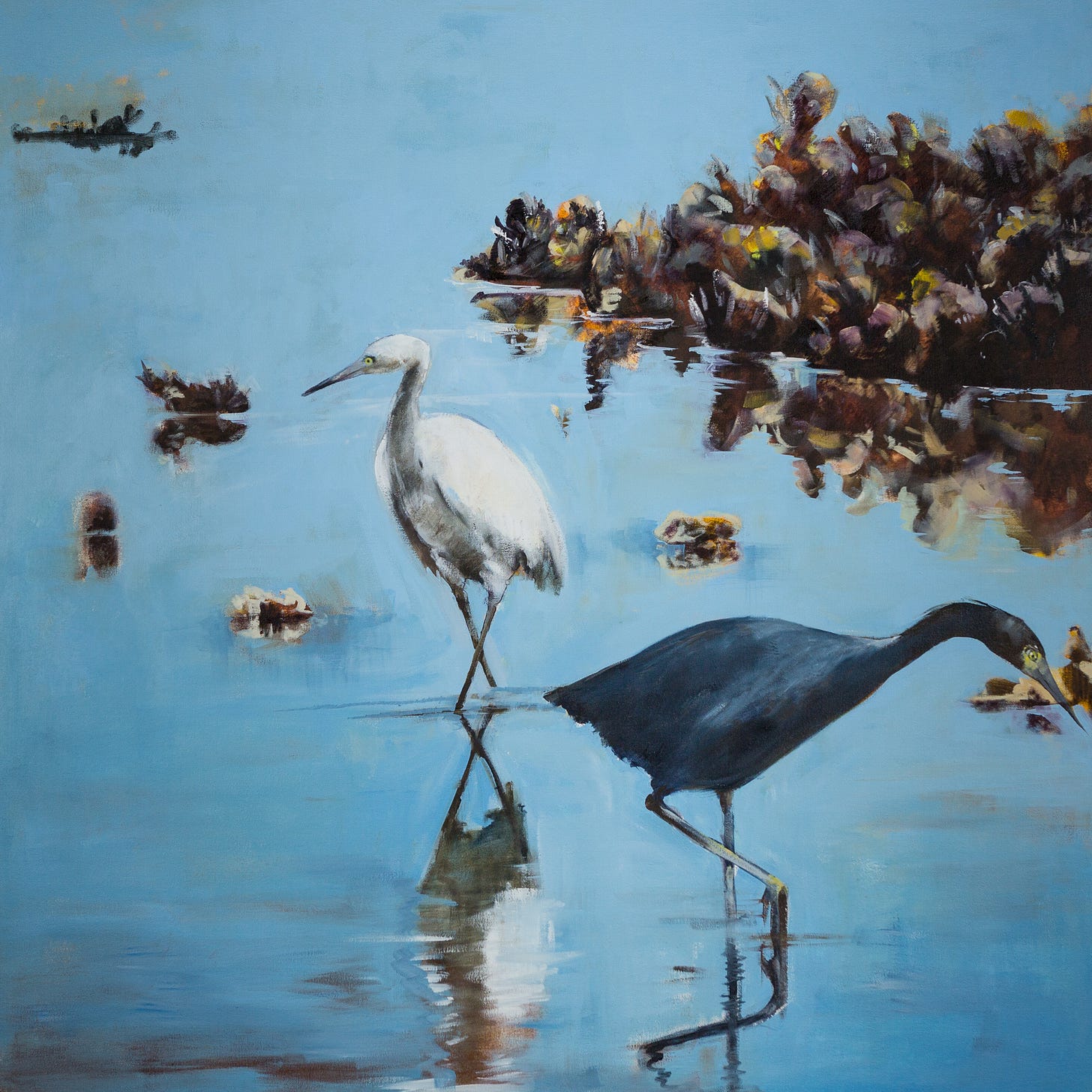Buttonbush: Cephalanthus occidentalis 48”x 48” oil on canvas 2012
This painting was created to memorialize a place on the Julington Durbin peninsula in Jacksonville, Florida. I hike the trail there often and am constantly thankful this land was set aside for us to have access to the marginal ecosystems of the St. Johns River. The peninsula is formed by Julington Creek on the north and Durbin Creek on the south. The property offers a unique laboratory for those who want to visit various ecosystems within a short stroll. The upper part of the land is typical sandy long leaf pine system with a varied understory of wire grass and assorted herbaceous perennials. A spur trail heads south to the always wet Durbin Creek backwater. This is where I found this specimen. I stood on a bridge and looked into the flower.
Buttonbush is an ubiquitous marginal native found in the southeastern US. Its abundance overshadows its distinctive beauty. Close study reveals an otherworldly form. It seems like it was designed as a mid-twentieth century spaceship. Satellite.
When I made this painting I wanted to draw attention to this plant that is seen often in the ditches as we drive seventy miles an hour down an interstate. I try to break as many rules of composition as possible when I paint. On this particular painting I chose the square format then I drew diagonal lines corner to corner. I placed a compass at the point dead center of the picture plane. Drew a circle. This image evoked all sorts of thoughts. Bullseye, the singular die cast, a focus, on and on.
My goal was to put the image of the flower dead center and also have it the lightest value in the composition. This presented the problem of breaking up the negative space in order to achieve all the other necessary elements of a successful composition.
The end result works for me. The dead-center focal point is both off-putting and soothing. The spectator is drawn into a delightful other-worldly ecosystem that is actually part of a commonplace scene.
I’m fascinated with language. My position as a late-in-life-literate helps me explore the nuanced ideas that an image can bring. The intent of this painting is to call attention to those scenes we catch from the corner of our eyes as we travel life’s highways. I memorialize them and celebrate the characters in the margins.
Cypress at Turner Bridge 72”x 108”oil on canvas 2012 in the collection of Park Adams. Bald Cypress Taxodium distichum
The Suwannee River heads up in the northern perimeter of the Okefenokee swamp. It crosses the Florida state line south of Fargo, Georgia and meanders south and west on its way to the Gulf of Mexico. I met this beauty soon after launching my kayak from the Turner Bridge ruins in Hamilton County, Florida. I placed the trunk in a position so that the viewer must circumnavigate the massive eroded root mass in order to travel the river. This particular section of the river is lined with both Bald Cypress and Tupelo trees. Heavy rains and high water rip through the narrow trough in this section. The force sculpts and shapes the stream bank and the vegetation.
Ogechee Lime 72”x108” oil on canvas 2012 collection of Ron and Hileah Autry
This tree is about a quarter mile’s paddle up the Suwannee river from the above Cypress. This tree Nyssa ogeche, lines this part of the Suwannee river. The spring blossoms are full of nectar for honey bees. The famous nectar, Tupelo Honey is produced by these trees. In the fall the drupes plop into the river and seed themselves along the margins.
Willie Browne’s Marsh. 48”x48” oil on canvas 2012
This tidal marsh is on the property formerly owned by Willie Browne. He preserved this land and made sure it stayed undisturbed in perpetuity. It is part of the Timucuan Preserve in northeast Jacksonville, FLorida. I often present a guide in paintings. In this case it is the Gulf Fritillary butterfly.
Blue Herons at Willie Browne Marsh. 48”x48” oil on canvas 2012
Here is another video. enjoy.








